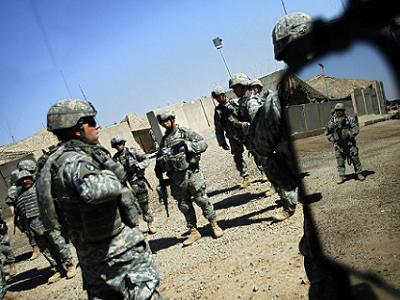The Iraq war ushered in dramatic advances in battlefield medicine, with the effects of homemade bombs leading the US military to radically change how it treats wounded soldiers.
Underpinning the new approach is a golden rule for American medics: to save a life, stop the bleeding first.
Out of the terrible carnage in Iraq, where 3,480 US soldiers were killed in combat and nearly 32,000 wounded in eight years of war that are now drawing to a close, doctors and medics learned how to treat injuries that had proved fatal in previous conflicts.
Close to 70 percent of the wounds came from homemade bombs that left critical burns, severed limbs and damaged lungs.
While body armor and newly-designed vehicles tried to counter the risk of improvised explosive devices (IEDs), the military changed its approach to treating those injured by the bombs.
As a result, American soldiers wounded in Iraq had a better chance of survival than in any previous US war, with more than 90 percent coming home compared to about 76 percent in the Vietnam conflict.
The biggest change came from a low-tech solution — tourniquets — which for nearly a hundred years had been dismissed as a device that could too easily cut off circulation and lead to amputations.
“When I was a medic, tourniquets were seen as the last resort,” said Lieutenant Colonel Robert Mabry, who as a Green Beret treated wounded soldiers in the battle of Mogadishu in 1993.
In previous conflicts, American medics did not even carry tourniquets but would have to improvise using whatever was at hand, including sticks. “Good luck finding a stick in Iraq or Afghanistan,” Mabry said.
Now American medics, and soldiers, carry a tourniquet that has been specially designed and tested. The new medical kit reflects the view of army doctors that in an emergency, stemming massive bleeding is more urgent than maintaining the flow of oxygen.
“You’ve got four minutes to get someone oxygen so their brain doesn’t start to die. But you really only have a few pumps of the heart before they’ve lost so much blood they’re not going to be able to live,” said Colonel Patricia Hastings, a doctor who edited a new textbook for medics and served as director of combat medical training.
According to a medical study carried out in Iraq, 862 tourniquets were applied to 459 wounds. About 87 percent of the troops survived their wounds, and not one suffered an amputation as a result of the tourniquet.
After looking at research on combat injuries in Vietnam, a small network of doctors and former medics concluded that the military’s approach was shaped too much by civilian emergency medicine instead of the realities of the battlefield.
“An ambush is different than an automobile accident. The injury patterns are different and also the hazards are different,” said Mabry, who has played a key role in rewriting the rules for casualty care.
Apart from tourniquets, medics now carry gauze impregnated with clotting agents, big needles and catheters used to release air from chest wounds, and special tubes to create emergency airways through the throat or nose. US medics also undergo much more extensive training compared to previous eras, with 16 weeks of instruction.
And even in the deserts of Iraq, medics now focus on keeping a wounded warrior warm, as hypothermia poses a serious threat for a patient that has lost large amounts of blood.
“Who would think you’d get cold in Iraq when it’s 120 degrees?” Hastings said, adding that “keeping the patient warm is much more critical than we ever knew before.”
But injecting intravenous fluid, long deemed vital by civilian paramedics and an iconic image from the Vietnam conflict, is no longer a top priority.
“I carried six liters of fluid in the field. Now medics are going on prolonged operations with a liter or liter and a half,” said Mabry, director of the emergency medical services and disaster medicine fellowship program at San Antonio Military Medical Center.
For injured soldiers who have stopped bleeding and are not in shock, there is no need for an IV, and in some cases, an intravenous fluid can do harm in a fragile patient that has lost a lot of blood, doctors said.
At field hospitals in Iraq, army physicians also employed new techniques and devices while improving how medical air evacuations were organized — lessons that have been applied to the war in Afghanistan.
The next challenge for combat casualty care are wounds to the belly, chest or neck that cannot be contained by a tourniquet, said Hastings, medical command liaison to the Department of Homeland Security.
“The thing we still haven’t figured out is what do you do about non-compressable hemorrage,” she said.
“That’s the next big advance we’re trying to get to.”










